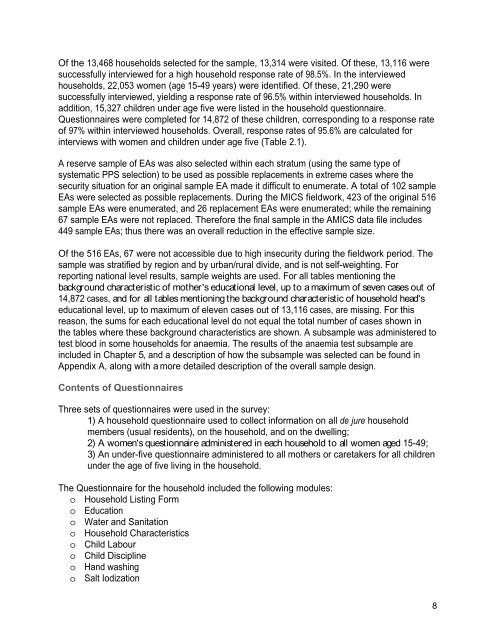Microsoft Word - AMICS-29Jan2013 - Childinfo.org
Microsoft Word - AMICS-29Jan2013 - Childinfo.org
Microsoft Word - AMICS-29Jan2013 - Childinfo.org
You also want an ePaper? Increase the reach of your titles
YUMPU automatically turns print PDFs into web optimized ePapers that Google loves.
Of the 13,468 households selected for the sample, 13,314 were visited. Of these, 13,116 were<br />
successfully interviewed for a high household response rate of 98.5%. In the interviewed<br />
households, 22,053 women (age 15-49 years) were identified. Of these, 21,290 were<br />
successfully interviewed, yielding a response rate of 96.5% within interviewed households. In<br />
addition, 15,327 children under age five were listed in the household questionnaire.<br />
Questionnaires were completed for 14,872 of these children, corresponding to a response rate<br />
of 97% within interviewed households. Overall, response rates of 95.6% are calculated for<br />
interviews with women and children under age five (Table 2.1).<br />
A reserve sample of EAs was also selected within each stratum (using the same type of<br />
systematic PPS selection) to be used as possible replacements in extreme cases where the<br />
security situation for an original sample EA made it difficult to enumerate. A total of 102 sample<br />
EAs were selected as possible replacements. During the MICS fieldwork, 423 of the original 516<br />
sample EAs were enumerated, and 26 replacement EAs were enumerated; while the remaining<br />
67 sample EAs were not replaced. Therefore the final sample in the <strong>AMICS</strong> data file includes<br />
449 sample EAs; thus there was an overall reduction in the effective sample size.<br />
Of the 516 EAs, 67 were not accessible due to high insecurity during the fieldwork period. The<br />
sample was stratified by region and by urban/rural divide, and is not self-weighting. For<br />
reporting national level results, sample weights are used. For all tables mentioning the<br />
background characteristic of mother s educational level, up to a maximum of seven cases out of<br />
14,872 cases, and for all tables mentioning the background characteristic of household head s<br />
educational level, up to maximum of eleven cases out of 13,116 cases, are missing. For this<br />
reason, the sums for each educational level do not equal the total number of cases shown in<br />
the tables where these background characteristics are shown. A subsample was administered to<br />
test blood in some households for anaemia. The results of the anaemia test subsample are<br />
included in Chapter 5, and a description of how the subsample was selected can be found in<br />
Appendix A, along with a more detailed description of the overall sample design.<br />
Contents of Questionnaires<br />
Three sets of questionnaires were used in the survey:<br />
1) A household questionnaire used to collect information on all de jure household<br />
members (usual residents), on the household, and on the dwelling;<br />
2) A women s questionnaire administered in each household to all women aged 15-49;<br />
3) An under-five questionnaire administered to all mothers or caretakers for all children<br />
under the age of five living in the household.<br />
The Questionnaire for the household included the following modules:<br />
o Household Listing Form<br />
o Education<br />
o Water and Sanitation<br />
o Household Characteristics<br />
o Child Labour<br />
o Child Discipline<br />
o Hand washing<br />
o Salt Iodization<br />
8

















